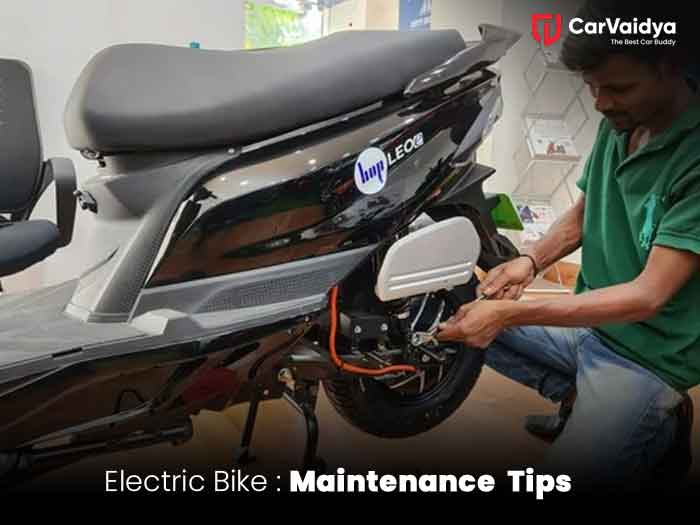Ensuring Longevity of Electric Bikes: Key Considerations for Prolonged Lifespan


 By CarVaidya
By CarVaidyaElectric bikes, also known as e-bikes, have gained immense popularity as sustainable and efficient modes of transportation. As more individuals embrace these eco-friendly alternatives, it becomes crucial to address the longevity of electric bikes and how to extend their lifespan. In this article, we will explore four key considerations to ensure the prolonged durability of electric bikes.
The battery is the heart of any electric bike, providing the necessary power for propulsion. Proper battery management and care are paramount for ensuring the long-term health of an electric bike.
Lithium-ion batteries, commonly used in electric bikes, have a finite number of charge cycles. It is essential to adopt optimal charging practices to maximize the battery's lifespan. Avoid deep discharges and opt for partial charges rather than letting the battery drain completely before recharging.
When storing an electric bike for an extended period, it is crucial to store it in a cool, dry place. Extreme temperatures, both hot and cold, can negatively impact battery performance. If storing for an extended period, ensure the battery is charged to around 50% to prevent over-discharge.
Periodic inspections of the battery are essential. Check for any physical damage, swelling, or abnormalities. If any issues are detected, it is advisable to consult the manufacturer or a professional technician for guidance.
Manufacturers often release firmware updates for electric bike batteries. These updates may include optimizations for battery management. Keeping the bike's firmware up-to-date can contribute to better overall battery health.
The electric motor is another critical component that directly influences the performance of an e-bike. Regular maintenance of the motor is vital to ensure it operates smoothly and efficiently over an extended period.
Dust, dirt, and debris can accumulate on the motor, affecting its performance. Regularly clean the motor area, ensuring that it remains free from contaminants. This simple practice can go a long way in preserving the motor's functionality.
The moving parts of an electric bike's motor may require lubrication to reduce friction and prevent wear and tear. Consult the manufacturer's guidelines for recommended lubricants and intervals for application.
Like batteries, the motor is sensitive to extreme temperatures. Operating an electric bike in excessively hot or cold conditions can strain the motor. When possible, avoid riding in extreme weather, and store the bike in moderate temperatures.
If any issues or unusual sounds arise from the motor, address them promptly. Timely repairs can prevent minor problems from escalating and potentially damaging the motor or other components.
Investing in a high-quality electric bike with durable components is a foundational step in ensuring its longevity. Paying attention to the quality of materials and components during the initial purchase can save considerable maintenance costs in the long run.
The frame is the backbone of the bike. Choose a frame made from sturdy materials such as aluminum or steel. These materials offer durability and can withstand the rigors of regular use.
Opt for a reliable braking system. Disc brakes, for example, provide efficient stopping power and often require less maintenance than traditional rim brakes. Regularly check and replace brake pads as needed.
Invest in high-quality tires with good tread and durable wheels. Proper tire inflation is essential for smooth rides and also contributes to the longevity of the wheel components.
If your electric bike features a suspension system, ensure that it is well-maintained. Regularly inspect and lubricate suspension components to prevent premature wear and maintain optimal performance.
The way an electric bike is ridden can significantly impact its overall lifespan. Adopting responsible and mindful riding practices contributes to the bike's longevity and reduces the likelihood of wear and tear.
Avoid abrupt starts and stops, as they can put unnecessary stress on the motor and brakes. Smooth acceleration and deceleration not only contribute to a more enjoyable ride but also prolong the lifespan of crucial components.
While electric bikes are designed to handle various terrains, it's advisable to avoid overly rough or challenging surfaces when possible. Excessive vibrations and shocks can accelerate wear on the bike's components.
Adhere to the manufacturer's weight limit recommendations. Overloading the bike can strain the motor, battery, and frame, leading to premature wear. Distribute weight evenly and avoid carrying loads beyond the bike's capacity.
Schedule regular check-ups or periodic service by the best mechanic for your electric bike, either through self-inspections or by consulting a professional technician. Detecting and addressing potential issues early can prevent more significant problems down the line.
Ensuring the long-term durability of electric bikes requires a combination of proper maintenance, responsible riding practices, and an initial investment in quality components. By following these considerations, e-bike owners can extend the lifespan of their vehicles, contributing to a more sustainable and enjoyable mode of transportation for years to come. Regular attention to the battery, motor, components, and riding habits forms a comprehensive approach to promoting the longevity of electric bikes in the ever-evolving landscape of sustainable transportation.
Installing Airbags in Older Car’s Safety Considerations and Effectiveness
The Essential Guide to Choosing the Right Car Driving School
Sustainable Logistics Practices Green Initiatives in the Automobile Industry


0 Comments